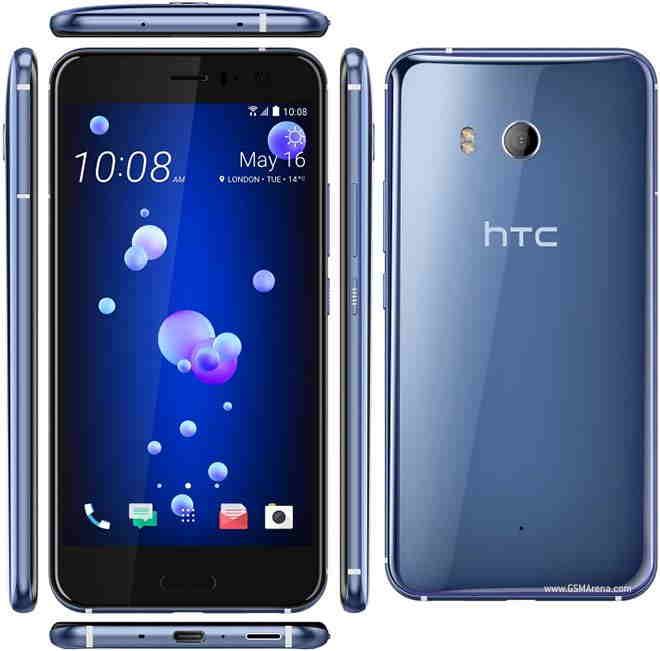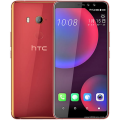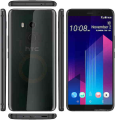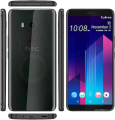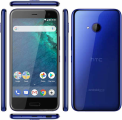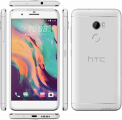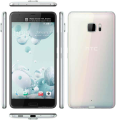
HTC U11 128 GB Prices
Important Note.
- All prices are in Pakistani Rupee (PKR)
- Prices may vary at stores and our effort will be to provide you with the updated prices.
- The latest price of HTC U11 128 GB was obtained on 17 مئی, 2019. The prices at the original stores had been updated on the respective mentioned dates.
- Find out WhatMobile price has dropped in Pakistan by selecting Notify Price Drop button
- Find out WhatMobile has better specifications by clicking Add To Compare Button find out what Mobile has better reviews by visiting our reviews section
- Find out WhatMobile is cheaper on which retailer by clicking Compare prices from retailers button
Search Terms
- HTC U11 128 GB
Specifications
| GENERAL | |
| 2G Network | GSM 850 / 900 / 1800 / 1900 - SIM 1 & SIM 2 (dual-SIM model only) |
|---|---|
| 3G Network | HSDPA 850 / 900 / 1900 / 2100 |
| 4G Network | LTE band 1(2100), 3(1800), 4(1700/2100), 5(850), 7(2600), 8(900), 12(700), 17(700), 20(800), 28(700), 32(1500), 38(2600), 39(1900), 40(2300), 41(2500) |
| Sim | Single SIM (Nano-SIM) or Hybrid Dual SIM (Nano-SIM, dual stand-by) - IP67 certified - dust and water resistant - Water resistant up to 1 meter and 30 minutes |
| Announced | 19/05/2017 |
| Status | Available. Released 2017, June |
| BODY | |
| Dimensions | 153.9 x 75.9 x 7.9 mm (6.06 x 2.99 x 0.31 in) |
| Weight | 169 g (5.96 oz) |
| DISPLAY | |
| Display Size | 5.5 inches, 83.4 cm2 (~71.4% screen-to-body ratio) |
| Resolution | 1440 x 2560 pixels, 16:9 ratio (~534 ppi density) |
| MultiTouch | Yes |
| Protection | Corning Gorilla Glass 5 - HTC Sense UI |
| SOUND | |
| AlertTypes | Vibration; MP3, WAV ringtones |
| LoudSpeaker | Yes, with stereo speakers |
| 3.5mm jack | No - 24-bit/192kHz audio - Active noise cancellation with dedicated mic |
| MEMORY | |
| CardSlot | microSD, up to 256 GB (uses SIM 2 slot) - dual SIM model only |
| Internal | 128 GB, 6 GB RAM - Global |
| DATA | |
| GPRS | Yes |
| EDGE | Yes |
| Speed | HSPA 42.2/5.76 Mbps, LTE-A (4CA) Cat16 1024/75 Mbps |
| WLAN | Wi-Fi 802.11 a/b/g/n/ac, dual-band, Wi-Fi Direct, DLNA, hotspot |
| Blue Tooth | 4.2, A2DP, LE (5.0 after SW update) |
| NFC | Yes |
| USB | 3.1, Type-C 1.0 reversible connector |
| CAMERA | |
| Camera Primary | 12 MP (f/1.7, 1.4 µm, Dual Pixel PDAF), phase detection autofocus, OIS, dual-LED dual-tone flash |
| Camera Features | Geo-tagging, touch focus, face detection, HDR, panorama |
| CameraVideo | 2160p@30fps, 1080p@30/60/120fps, HDR, 24-bit/192kHz stereo sound rec. |
| CameraSecondary | 16 MP, f/2.0, 1080p |
| FEATURES | |
| Processor Cores | Octa-Core |
| OS | Android 7.1 (Nougat), upgradable to Android 8.0 (Oreo) |
| CPU | Octa-core (4x2.45 GHz Kryo & 4x1.9 GHz Kryo) |
| Sensors | Fingerprint (front-mounted), accelerometer, gyro, proximity, compass |
| Messaging | SMS (threaded view), MMS, Email, Push Email |
| Browser | HTML5 |
| Radio | No |
| GPS | Yes, with A-GPS, GLONASS, BDS |
| Java | No |
| Colors | Amazing Silver, Sapphire Blue, Brilliant Black, Ice White, Solar Red |
| Others | - Fast battery charging (Quick Charge 3.0) - Google Drive (100 GB cloud storage) - XviD/MP4/H.264/WMV player - MP3/eAAC+/WMA/WAV/FLAC player - Document editor - Photo/video editor |
| BATTERY | |
| Battery | Non-removable Li-Ion 3000 mAh battery |
| StandBy | Up to 336 h (3G) |
| TalkTime | Up to 24 h 30 min (3G) |
| MISC | |
Reviews
13/06/2017 - 3:31pm
The HTC U11 has finally arrived. This is the first HTC device to be equipped with Qualcomm's powerful Snapdragon 835 processor. It's also allegedly got a smashing camera and is a fully waterproofed IP67 certified phone.
We'll be looking at many of these features in much more detail in our full review, but in the meantime, here are our first impressions having just unboxed the handset.
HTC U11 Design & Build
As I lift the HTC U11 out of its box the first thing I notice upon turning it over is that it is shiny.
Very shiny.
For my taste rather too shiny if I am totally honest.
The back panel has this chromed mirror finish, in this case with a sort of pale blue tint. I just think it’s a bit too bling.
My understanding though is this isn’t something you’ll be able to escape on just about any colour option you choose from the range; they’ve all got that high-shine on the glass backing in high contrast to the matte finish, brushed aluminium surround in which it sits. I’m familiar with glossy glass back panels acting as fingerprint magnets, but this one is something else entirely! Indeed, the handset is supplied with a cloth, almost a nod to how smeared it will get within seconds of picking it up.
As well as the bling factor, I for one do not enjoy seeing my own mug staring back at me whenever I look at the phone’s backing, particularly given how the shape of the surface means it acts rather like a freaky circus mirror and readily warps you into some kind of square-headed, goggle-eyed Frankenstein with the merest twitch of the wrist.
In terms of overall shape and design, there are a few echoes of the Samsung Galaxy S8 and Apple’s iPhone 7 in here, which is an interesting turn as I’m so used to HTC forging its own very distinct path. It’s a pretty standardised glass sandwich, with the metal body housing antenna bands at either end and curved and tapered glass front and back panels - they curve round the edges similar to the Galaxy S8 design, but this is just the glass panels not the display underneath, which is flat and stays very much on the front.
It’s a reasonably attractive design style which I can’t really fault, but I do think the mirror finish really detracts from it immensely.
On a positive note, the power key and volume rocker are well-implemented with a robust feel and metal build, solid click feedback in operation, and a ridged texture on the power key, which is always welcome and we just don’t see enough of in the current market.
Similarly, another good thing is the IP67 water and dust proofing, making this one of very few (if any?) HTC smartphones to date where I don’t have to worry about getting it wet.
HTC U11 Display
Once upon a time, HTC’s displays really impressed me. To clarify, I still think they are good. Very good, in fact. But the problem is tech doesn’t exist in a vacuum and sometimes other things come along which set a new standard. The HTC U11’s 5.5in Super LCD5 display is great; viewing angles are nice and wide, brightness and colour are good, and white purity is particularly impressive. However, the screen lacks punch in terms of contrast and black depth; the latter in particular with blacks and darker hues looking a bit grey and soupy compared to the shiny pitch gloss of the bodywork surround it immediately sits next to.
There’s no nice way of putting this, but compared to recent AMOLED offerings (yes, Samsung) stuff like this, even though it is very good, just doesn’t blow my socks off anymore. It’s good, but it’s not the best. It could be better. A lot better. We’ve seen how good things can be, and this falls short.
I can’t complain about clarity, mind, this thing is very sharp.
HTC U11 Software & Performance
Naturally, this isn’t going to be an in-depth look at the software package or the performance, particularly the latter - such things will have to wait for the full review verdict. But in terms of initial impressions, I can say is reassuringly snappy and agile in terms of navigating around Android with smooth, precise control. So far, no hiccups even when spamming a bunch of apps in the background.
In terms of the actual software package though, this is Android 7.1 Nougat with the latest HTC Sense UI on top. And very smart it is too, I’ve liked Sense for a long while now and it shows all the same flair and panache with plenty of neat little tweaks and improvements along the way. Visually it is very clean and straightforward and nicely optimised.
It really just overflows with Android’s Material Design ethos as this sort of colourful paper cut-out style, but really nicely animated in a smooth way, and efficiently and intelligently laid out.
HTC U11 Initial Impressions
I’m feeling this is a bit of a mixed bag. On the one hand a lot of what immediately jumps out at me about the HTC U11 I am not very fond of, and it’s stuff that I don’t think is going to change as I use it. I am probably not going to become fond of that shiny back panel with more exposure, for example, but I’ll concede that a protective case will fix that issue straight away so perhaps it’s not worth making too much of a fuss over.
The really telling thing will be the hardware and software experience going forward in further depth, as well as getting to grips with the HTC Companion package, and the handset’s camera, which has been highly praised elsewhere. All of these things look quite positive from the outset - but are they going to be good enough to counter my grievances with the design and display?
Of particular importance will be the battery life, which on the last few HTC flagships has been less than impressive. Stay tuned for our full review in the coming weeks.
Write Your Own Review
My Recent Reviews
- Be first to post review for this product.
comments powered by Disqus




